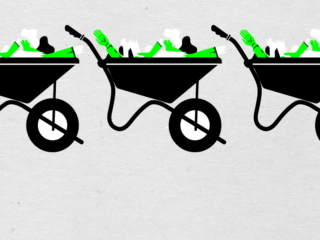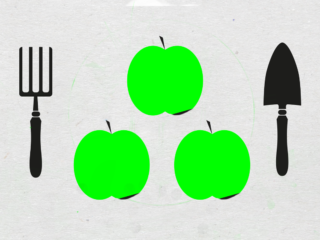How to fence out critters?
Let us count the ways

No matter where you garden, everywhere from a town balcony to a five-acre field will have one problem in common: animals. Hungry animals; who, bless ’em, look on vegetable and fruit beds as their version of Supermarket Sweep. Give them any kind of access and they will romp through the aisles/beds, eating the hell out of all your crops.
Back in the bad old, good old days, farmers and market gardeners used to trap, shoot and/or poison any animal that threatened their crop. Come the apocalypse, who’s to say you wouldn’t find yourself doing the same? But until the world ends, a kinder, less bloody approach is simply to shut the buggers out.
It took us roughly three years to work out which fences and/or barriers kept which kind of animal at bay – three years in which we repeatedly lost any number of plants, from beds of seedlings all the way up to entire fruiting hedges. To save you suffering the same pain, here, on a critter-by-critter basis, are the best options we’ve come across.
No 1: Cats and Foxes
These rarely actually eat zombie-garden crops, but they do like to lie down in, dig up, and/or heavily crap on them. Which is annoying. They’ll make their presence felt in pretty much any garden site (apart from maybe a balcony), so we’d recommend you give some thought to how to protect against them, particularly when plants are small and easily upset.
- First off, you could try deterrents like anti-cat sprays, motion-sensitive sprinklers etc. These are all quite pricey – as well as too hit and miss, in our opinion, to be worth bothering with.
- While we’re all for barriers, trying to build a fence to keep a cat or a fox out is pointless – they’re just too agile, and always seem to find a way up and over. For a very small area, you could take a tip from gardeners who keep hens, and build a kind of cage for your beds out of chicken wire or netting. But that costs time and money.
- On the other hand, hooped cloche tunnels covered in insect net or mesh with both ends tightly closed will keep both foxes and cats off your beds.
- If you don’t have time for building cloche tunnels, stick loads of twigs and branches into the soil among your plants. This discourages cats in particular, and also keeps large birds like pigeons, pheasants and crows away from tender seedlings.
- Get a dog. Preferably a biggish boy dog, and let him pee in the garden every now and again so that other animals smell predator. This won’t put cats or foxes off for long, but it will make them a bit less likely to treat your garden like a combined hotel and luxury toilet.
No 2: Deer
Not, we admit, a problem for urban gardeners. But the UK feral deer population (mostly fallow, roe and muntjac) is booming, and anyone growing food outside towns and cities will likely have trouble with them before too long. A full grown fallow deer stag can leap up to a staggering eight foot high and across in one go, which makes stopping him from getting at things pretty tricky. But it is necessary. If D is for deer, it’s also for destructive. They’ll chomp up all the fruit in a fruit tree, which is annoying. But worse is the damage deer do to the parent plant. Any new perennial, fruit tree or shrub has to be completely protected from deer or they’ll repeatedly eat it down almost to the ground, where rabbits will finish it off.
So, how to keep them out? Commercial foresters and people with really stupid amounts of money use metal-mesh fencing on metal posts. It’s pretty much foolproof, and lasts forever – but as well as costing a fortune, an 8ft high metal fence looks vile, like you’re growing veg in a prison yard. And yes, we know that’s what Rick Grimes did in The Walking Dead, but then he went mad and started talking to his wife’s ghost, so he’s hardly the best model.
Some woodlanders reckon you can keep deer, especially smaller species such as muntjac, out of an area by digging a deep ditch all the way round it, mounding up the earth on the far side, then topping the mound with a thick barrier of of brashing (cut branches) woven between bashed-in poles. Some woodlanders, it strikes us, have too much time on their hands.
Also a possibility is an imported Swedish product called Plantsykdd (basically: dried, powdered blood), which you mix with water and then spray on and around plants you want to protect, as this makes deer think a predator has been killing things nearby. It’s mucky, stinky and, in our experience, stopped working after a few weeks, so you have to keep re-buying and re-spraying. Which means also with the expense.
An alternative to powdered repellent is the old country trick of hanging bags of human hair anywhere a deer might want to nibble – they’re not keen on people, seeing as how we have a tendency to shoot them with high-powered rifles. Still, how much hair will one gardener have to spare?
Deer don’t seem to like jumping into places that they can’t see into, or see a way out of, so visual barriers can help. After we put up wattle panels to the south of our orchard, deer stopped trying to get in that way. On the same note, we planted native mixed hedging all around the existing stock fence in our main veg-growing area. We let this grow thick and high in the summer, so that deer can’t see what’s on the other side. So far this keeps them out, but in winter – when the hedges are bare, and the deer are likely to be hungrier and less risk-averse – we double-down and protect the veg beds with bird net.
The cheapest way of properly keeping deer out of an area that we’ve found is C-Flex black plastic deer netting. It’s light, unobtrusive and easy to handle, and comes in different heights, This is handy, as a fence to keep out roe deer only needs to be 5ft high, while one for fallow or red deer needs to be at least 6ft. [1]
No 3: Rabbits and badgers
Bunnies are fluffy, cute – and lethal. They will eat grass, yes, but also pretty much everything green that grows in the ground, from seedlings to mature leafy crops. They’ll also attack the lower parts of shrubby plants, standing on their back legs to bite off the growing tips of young branches, and they love to gnaw the bark off fruit bushes and the trunks of trees. This has much the same effect as flaying alive has on humans. No one mentioned that in “Watership Down”.
Anyone starting a veg garden on ground even slightly close to open countryside, or even a large park, will have to give some thought to how to keep rabbits away. Deterrents are mostly similar to those for deer: anything that smells of predators, like hair or blood, might put them off for a beat or too, but won’t as a rule be reliable enough for long enough to keep your crops safe. Cardboard tree-protector tubes that decompose after 3 years (much better than the old-fashioned plastic kind, which went brittle and shredded in way that would give David Attenborough a heart attack) will protect the trunks of young fruit trees from nibbling. If you have one or two individual fruit bushes, or a few perennial veg plants such as rhubarb, you can protect these with a circle of chicken wire, fixed with twine or cable ties to bamboo stakes. But be aware that bunnies like to dig wherever they find an edge, so sometimes the chicken wire actually encourages them to burrow down and disturb the roots of your plants – and this can be even more destructive than a bit of munching on top-growth. As a rule, though, fencing the whole of your growing area so that bunnies can’t get in will, in the end, save you a lot of time and heartache.
As for badgers, they are the bulldozers of the animal world. Incredibly strong and single-minded, they blast through all but the sturdiest fencing to get at sweet treats like soft fruit or young broad bean pods. And once in your garden, they will flatten everything around them: a bed of raspberry canes that’s been visited by a badger looks like Tokyo after Godzilla’s been in town .
Luckily for you, after a lot of trial and error, we developed a way of fencing that keeps out deer, rabbits and badgers. Here’s how.

First, the primary barrier
This is basically deer netting. Best practice, according to the manufacturers, is to fix the netting to metal posts, attaching it along its top edges to strained metal wires, but that all gets very expensive and Tenko-looking. Instead we use relatively cheap, unpeeled chestnut posts cut by a local forester, bang them into (soft) ground with a hand held post-driver, then attach the netting to the poles using thin battens and nails. If you buy in big enough quantities you can order 100m rolls of C-Flex direct from Tenax, but retailers like Amazon and Harrod Horticultural sell it in smaller lengths. And yes, it’s plastic – but it’s very hard-wearing and we have used and reused ours over and over again.
Secondary barrier
Rabbits can easily push through deer netting, so to keep them out you’ll need a roll of 1.8m wide chicken wire. Run this around the outside of the primary barrier, laying two thirds of its width flat on the ground, and the other third vertically up against the deer netting. Even if they climb up the chicken wire, they can’t push through the deer net when they get to the top. The netting on the ground will stop them digging their way under the fence into your garden, as they don’t like the feel of the wire under their little rabbity paws.
Tertiary barrier
Badgers laugh in the face of both deer net fence and chicken wire: they use their teeth and hooked claws to cut through it as if it were butter. Wipe the grin off their furry two-tone faces by stacking two lots of 22cm-high wooden gravel board on top of each other all the way around the base of the entire perimeter.
Fourthary barrier (this is a thing)
Gates and other entry points also need be high enough to keep out deer, and possibly zombies. Barred, as opposed to solid, gates will need to be chicken-wired to stop rabbits getting through the gaps. And as few gates will meet the ground evenly all the way along, lay a badger board on edge a few inches inside the gate, with a packed earth or concrete slope on either side so that you can get your wheelbarrow over it.
That’s it, you are now completely protected from our furry friends. As for how to protect against birds and insects, we’ll post about this another day. Until then, happy fencing!

Soft fruit Either a) an easily led Liverpudlian banana, or b) low-growing fruit from bushes, canes or perennials, such as blackcurrants, raspberries and strawberries.

[1] Based on advice from Natural England and the Rural Payments Agency










